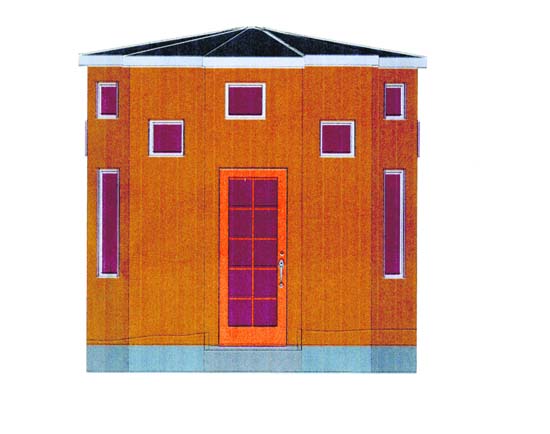| | Published April 29th, 2009
| A New Construction at "The Crosses"
| | By Sophie Braccini |  | | Drawing provided by Jeff Heaton
|
Reverend Jeff Heaton is not shy about implementing new ideas in the realm of social justice. The long time Lafayette activist, who has been instrumental in the erecting of the commemorative crosses in Lafayette, has designed a lightweight, mobile homeless shelter that is easily replicable and transportable, either to disaster areas, or to help local homeless people. The first prototype will be erected at the crossing of Oak Hill Road and Deer Hill Road by a group of volunteers at the beginning of May. Heaton says he intends to use the structure as a storage shed.
 "Jeff Heaton met with us to check that his structure would have all the characteristics of an accessory building, which, under Lafayette's building code, does not require a building permit," said Lafayette assistant planner Michael Cass. According to the specification of an accessory building, the shed has no plumbing or electricity and is not considered a livable space.
"Jeff Heaton met with us to check that his structure would have all the characteristics of an accessory building, which, under Lafayette's building code, does not require a building permit," said Lafayette assistant planner Michael Cass. According to the specification of an accessory building, the shed has no plumbing or electricity and is not considered a livable space.
 "The shed, that I call the Peace Hut, will be used to store our material," confirmed Heaton, "no one will live there; it is a prototype for a shelter that could be built somewhere else."
"The shed, that I call the Peace Hut, will be used to store our material," confirmed Heaton, "no one will live there; it is a prototype for a shelter that could be built somewhere else."
 "If Mr. Heaton wants to show it as a prototype that could be built elsewhere, that's okay," added Cass, "but if he wants to make it habitable then he will need a permit."
"If Mr. Heaton wants to show it as a prototype that could be built elsewhere, that's okay," added Cass, "but if he wants to make it habitable then he will need a permit."
 Heaton's motivation comes from his own experience. "A few years ago, I housed a homeless Vietnam veteran on my home for three years, before a permanent solution was found for him," recalls Heaton. "Some of our veterans are homeless and the shelter we are building could be a solution for them as well."
Heaton's motivation comes from his own experience. "A few years ago, I housed a homeless Vietnam veteran on my home for three years, before a permanent solution was found for him," recalls Heaton. "Some of our veterans are homeless and the shelter we are building could be a solution for them as well."
 Heaton had worked previously building a home with insulated concrete forms (ICF) and gained first hand experience with the durability and versatility of the forms made of foam, even when concrete is not poured between them. He experimented with the material in his home and researched the optimal shape that would offer 120 square feet of living space with maximum structural strength, minimal loss of energy, that was lightweight and easily assembled.
Heaton had worked previously building a home with insulated concrete forms (ICF) and gained first hand experience with the durability and versatility of the forms made of foam, even when concrete is not poured between them. He experimented with the material in his home and researched the optimal shape that would offer 120 square feet of living space with maximum structural strength, minimal loss of energy, that was lightweight and easily assembled.
 The structure he invented is a dodecagon, made of 12 panels, 3 feet by 12 feet. The panels will be made of 3 layers of recycled Styrofoam sheets, integrated with light-gage steal, for reinforcement, which will be clipped together. A light coat of stucco will cover the outside; the roof will be made of the same material. For the windows and the door, Heaton intends to employ the stained glass technique that is used to decorate some of the crosses, a mix of recycled broken glass and resin.
The structure he invented is a dodecagon, made of 12 panels, 3 feet by 12 feet. The panels will be made of 3 layers of recycled Styrofoam sheets, integrated with light-gage steal, for reinforcement, which will be clipped together. A light coat of stucco will cover the outside; the roof will be made of the same material. For the windows and the door, Heaton intends to employ the stained glass technique that is used to decorate some of the crosses, a mix of recycled broken glass and resin.
 The cost of the construction is presently about $2,000. Heaton hopes that mass production of the panels would reduce the cost. "This shelter is a work in progress," he said, "different versions can be made, with for example recycled wood between the sheets of foam for extra durability. What counts is that we find a replicable solution for the homeless."
The cost of the construction is presently about $2,000. Heaton hopes that mass production of the panels would reduce the cost. "This shelter is a work in progress," he said, "different versions can be made, with for example recycled wood between the sheets of foam for extra durability. What counts is that we find a replicable solution for the homeless."

|
| |
| | | |
